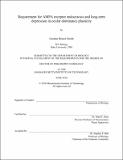Requirement for AMPA receptor endocytosis and long-term depression in ocular dominance plasticity
Author(s)
Smith, Gordon Brawn
DownloadFull printable version (4.386Mb)
Other Contributors
Massachusetts Institute of Technology. Dept. of Biology.
Advisor
Mark F. Bear.
Terms of use
Metadata
Show full item recordAbstract
The classic example of experience-dependent cortical plasticity is the ocular dominance (OD) shift in visual cortex following monocular deprivation (MD). As in other mammals with binocular vision, MD in mice induces bidirectional plasticity: rapid weakening of responses evoked through the deprived eye is followed by delayed strengthening of open-eye responses. It has been proposed that these bidirectional changes occur through three distinct processes. First, deprived-eye responses rapidly weaken through homosynaptic long-term depression (LTD). As the period of deprivation progresses, the modification threshold determining the boundary between synaptic depression and synaptic potentiation becomes lower via a decrease in the ratio of NR2A to NR2B N-methyl-d-aspartate receptor (NMDAR) subunits. Facilitated by the decreased modification threshold, open-eye responses are strengthened via homosynaptic longterm potentiation (LTP). One established LTD mechanism is a loss of sensitivity to the neurotransmitter glutamate caused by internalization of postsynaptic a-amino-3-hydroxy-5-methyl-4-isoxazole propionic acid receptors (AMPARs). Although it has been shown that MD similarly causes a loss of AMPARs from visual cortical synapses, the contribution of this change to OD plasticity has not been established. Here we develop a herpes-simplex virus (HSV) vector to express a peptide (G2CT) in visual cortical neurons designed to block AMPAR internalization by hindering the association of the C-terminal tail of the AMPAR GluR2 subunit with the AP2 clathrin adaptor complex. We find that G2CT expression interferes with NMDAR-dependent AMPAR endocytosis and LTD, without affecting baseline synaptic transmission. When expressed in vivo, G2CT completely blocks the MD-induced depression of deprived-eye responses after MD without affecting baseline visual responsiveness or experience-dependent response potentiation in layer 4 of visual cortex. Additionally, we find that OD plasticity in layer 2/3 can occur in the absence of plasticity in layer 4, demonstrating the independence of OD plasticity across laminae. These data suggest that AMPAR internalization is essential for the loss of synaptic strength in layer 4 of the visual cortex following MD. This finding illustrates a critical role for LTD mechanisms in the physiological response to sensory deprivation, thereby suggesting potential therapeutic strategies in the treatment of amblyopia.
Description
Thesis (Ph. D.)--Massachusetts Institute of Technology, Dept. of Biology, 2010. This electronic version was submitted by the student author. The certified thesis is available in the Institute Archives and Special Collections. Cataloged from student submitted PDF version of thesis. Includes bibliographical references (p. 168-179).
Date issued
2010Department
Massachusetts Institute of Technology. Department of BiologyPublisher
Massachusetts Institute of Technology
Keywords
Biology.